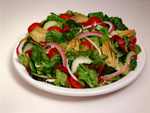 There are so many food cures in the supermarket, but many non-healthy items may be hiding behind some misleading labels. People who want to eat nutritiously aim to select nutrient-dense, healing foods, but many food labels can steer you down the wrong track. A new study highlights this issue, as dieters are so involved with trying to eat well that they are at risk of choosing unhealthy foods that are labeled as healthy.
There are so many food cures in the supermarket, but many non-healthy items may be hiding behind some misleading labels. People who want to eat nutritiously aim to select nutrient-dense, healing foods, but many food labels can steer you down the wrong track. A new study highlights this issue, as dieters are so involved with trying to eat well that they are at risk of choosing unhealthy foods that are labeled as healthy.
One thing that jumps out is that focusing on food names can work to your disadvantage. For example, salad. For lunch, many people trying to shed pounds will elect for a salad, which should be a healthy selection. But before congratulating yourself on making a healthy choice, make sure that salad is actually nutritious and low in calories and fat.
Be particularly vigilant when in restaurants. These days, salads can include ingredients that dieters would be likely to avoid (meats, cheeses, breads, pasta). Potato chips are labeled “veggie chips,” high-fat shakes are deemed “smoothies,” and sugar-filled beverages are named “flavored water” and “energy drinks.” It can be confusing and that confusion is not accidental.
Dieters tend to learn to avoid foods they recognize as being forbidden based on name. Hence why “pasta” is immediately believed less healthy than a “salad.” But attention must be paid to other product information that might unearth unhealthy ingredients. Ironically, non-dieters on the other hand are more likely to dismiss cues that imply healthfulness because they are not as focused on healthy selections.
In one study, participants received a mix of vegetables, pasta, salami, and cheese, served on a bed of fresh romaine lettuce. The item was either identified as “salad” or “pasta.” When it was called pasta, dieters perceived it as less healthy.
In another study, participants were given samples of a product, which was labeled either “fruit chews” or “candy chews.” Dieters perceived the unhealthy-sounding candy chews to be less healthful and less tasty than non-dieters. People ate more of the items when they were called fruit chews.
In short, the health tips here are clear: look beyond names and look beyond labels. When eating healthy, make sure you are eating healthy.
